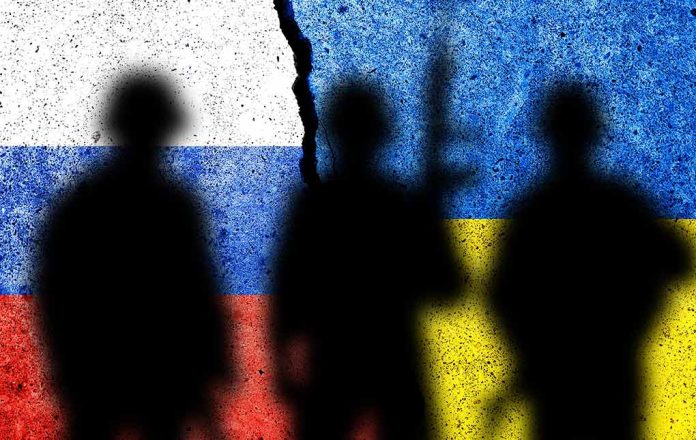
Russian official Dmitry Medvedev’s chilling threat that “Kyiv might not survive” if Ukraine attacks during May 9 Victory Day celebrations reveals the explosive tension surrounding competing ceasefire proposals ahead of the Soviet victory anniversary.
Key Takeaways
- Russia offered a three-day ceasefire (May 8-10) for Victory Day celebrations, which Ukraine dismissed as a “theatrical show”
- Ukraine and European allies proposed a 30-day ceasefire, citing safety concerns for foreign leaders attending Moscow’s May 9 commemorations
- President Trump previously proposed a permanent ceasefire plan giving Russia control of Crimea and parts of eastern Ukraine, which Ukraine found too conciliatory
- Russian official Dmitry Medvedev issued a stark warning that “nobody will be able to guarantee that Kyiv will live to see May 10” if Ukraine provokes during Victory Day
- Fighting continues with Russia launching drone attacks on Kyiv residential areas while battle intensifies around Pokrovsk in eastern Ukraine
Competing Ceasefire Proposals Highlight Deep Divides
The geopolitical chess match between Russia and Ukraine has intensified with competing ceasefire proposals ahead of the significant May 9 Victory Day celebrations in Moscow. President Vladimir Putin announced a unilateral three-day ceasefire from May 8-10, ostensibly to allow for commemorations of the 80-year milestone since Soviet victory in World War II. Ukrainian President Volodymyr Zelenskyy promptly rejected this proposal, characterizing it as a manipulative “theatrical show” designed for propaganda rather than peace.
In response, Ukraine and its European allies proposed a more extended 30-day ceasefire. This counter-offer comes amid heightened concern for the safety of world leaders expected to attend Moscow’s celebrations. The stark contrast between these proposals reveals the fundamental mistrust between the warring parties and highlights how even temporary peace measures have become weapons in the broader information war. Meanwhile, President Trump’s earlier permanent ceasefire plan, which recognized Russian territorial claims, has been largely sidelined as too favorable to Moscow.
Medvedev’s Ominous Warning Raises Stakes
The temperature of rhetoric surrounding the May 9 commemorations reached dangerous levels when Dmitry Medvedev, deputy chairman of Russia’s Security Council and former president, issued what amounts to a death threat against the Ukrainian capital. His warning came in direct response to Zelenskyy’s statement that Ukraine cannot guarantee the safety of foreign leaders attending Victory Day celebrations in Moscow. The exchange reveals the hair-trigger nature of tensions as the anniversary approaches.
“(Zelenskiy) understands that in the event of a real provocation on Victory Day, nobody will be able to guarantee that Kyiv will live to see May 10,” said Dmitry Medvedev
This threatening language from a high-ranking Russian official should alarm anyone who remembers that Russia has historically used significant national celebrations as cover for escalating military operations. With North Korean military assistance now officially acknowledged in Russia’s border regions and increased Russian military presence reported along EU and NATO borders, particularly near Finland, Moscow appears to be positioning itself for potential expanded conflict rather than de-escalation.
European Leaders Call for Pressure on Russia as Violence Continues
Despite discussions of ceasefires, the reality on the ground shows Russia’s true intentions. Even while claiming to seek peace, Russian forces launched drone attacks on Kyiv, causing fires in residential areas. Intense fighting continues in eastern Ukraine, particularly around Pokrovsk in the Donetsk region. The disconnect between Russia’s diplomatic posturing and its continued aggression has not gone unnoticed by European leaders like Estonia’s Prime Minister Kaja Kallas.
“While claiming to seek peace, Russia launched a deadly air attack on Kyiv. This isn’t a pursuit of peace, it’s a mockery of it. The real obstacle is not Ukraine, but Russia, whose war aims have not changed,” said Kaja Kallas
Czech President Petr Pavel echoed this sentiment during Zelenskyy’s visit to the Czech Republic, emphasizing that “If someone has all the cards in their hand to end the war then it is President Putin, who can do it with a single decision.” The European position stands in stark contrast to the Trump administration’s approach, which has reportedly withdrawn from discussions following Ukraine’s rejection of its more Russia-friendly peace proposal. This leaves Ukraine increasingly dependent on European support in both military and diplomatic arenas.
The Stark Reality Behind Ceasefire Theater
The timing of these competing ceasefire proposals reveals the cynical reality of Russia’s war strategy. Putin’s three-day pause offers Moscow a propaganda victory while ensuring minimal impact on battlefield operations. Meanwhile, Ukraine and Europe’s push for a 30-day ceasefire represents a desperate attempt to create space for meaningful diplomatic engagement. The fundamental problem remains that Russia shows no interest in genuine peace negotiations unless they codify its territorial conquest.
“If you want the killing to stop, you should put the pressure on Russia, who actually does the killing,” said Kaja Kallas
While Putin publicly downplays the potential use of nuclear weapons in Ukraine and expresses hope for future reconciliation, his actions tell a different story. Russia’s rejection of the European-Ukrainian peace proposals, its opposition to NATO forces in Ukraine, and its demand for Ukrainian military reduction all point to a nation seeking victory, not compromise. As world leaders navigate the dangerous waters surrounding May 9, the greatest concern should be that this anniversary becomes not a celebration of a past victory, but the pretext for a dangerous new escalation in a war that has already cost too many lives.







